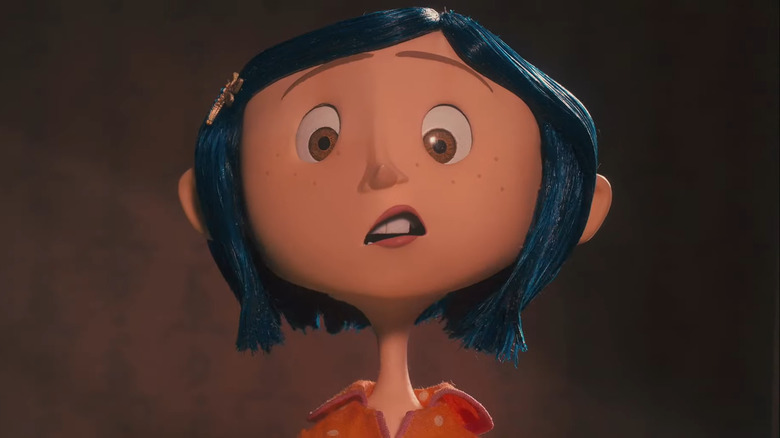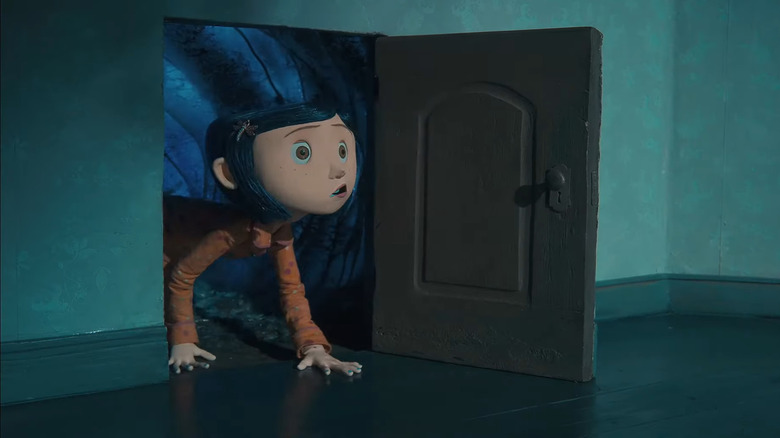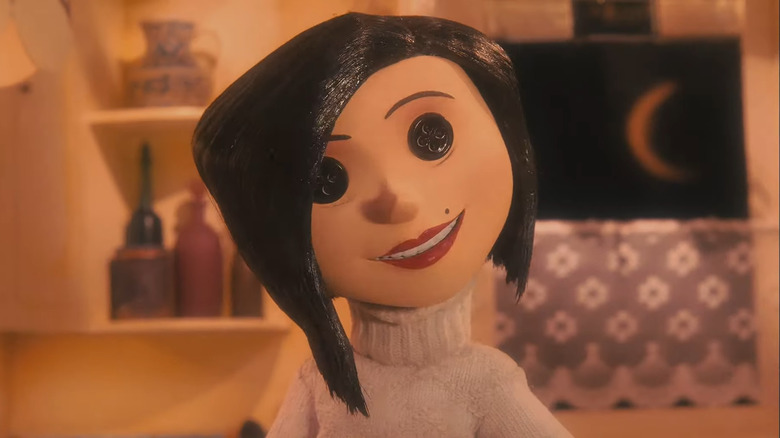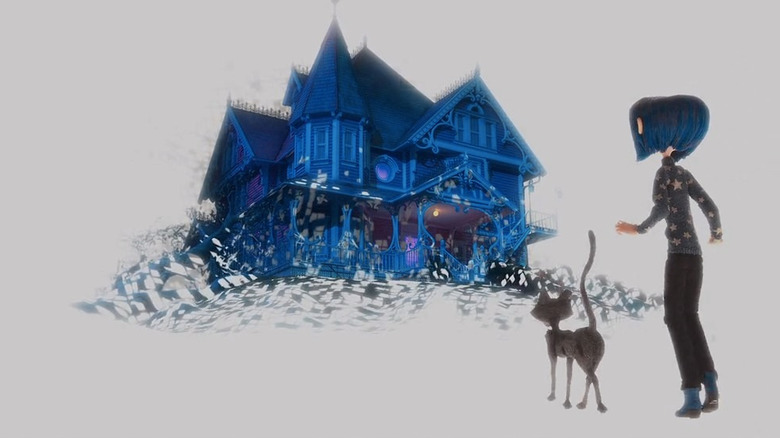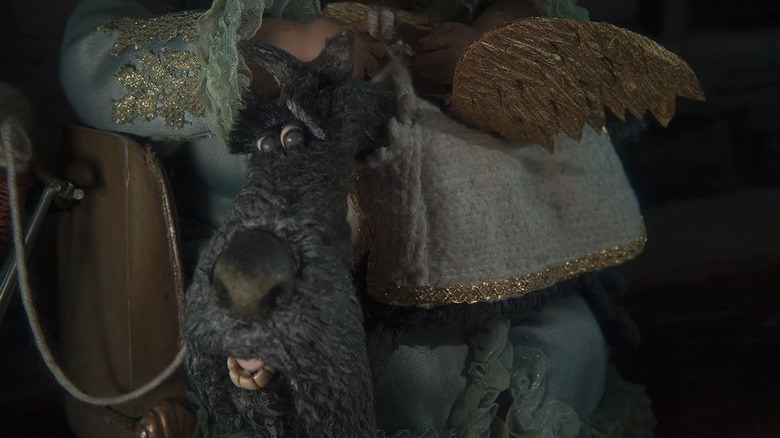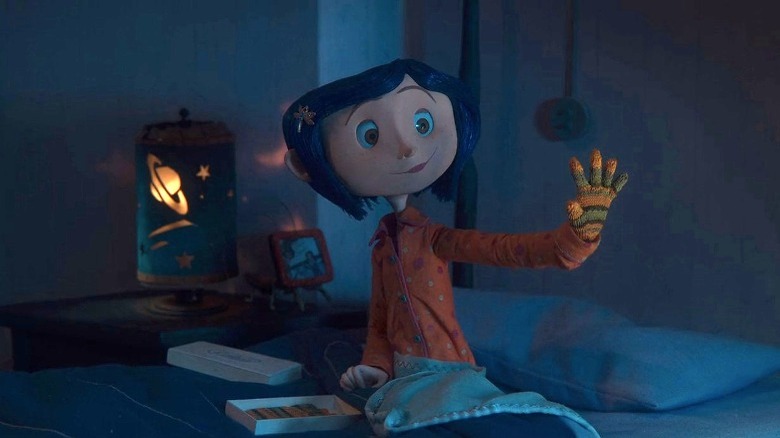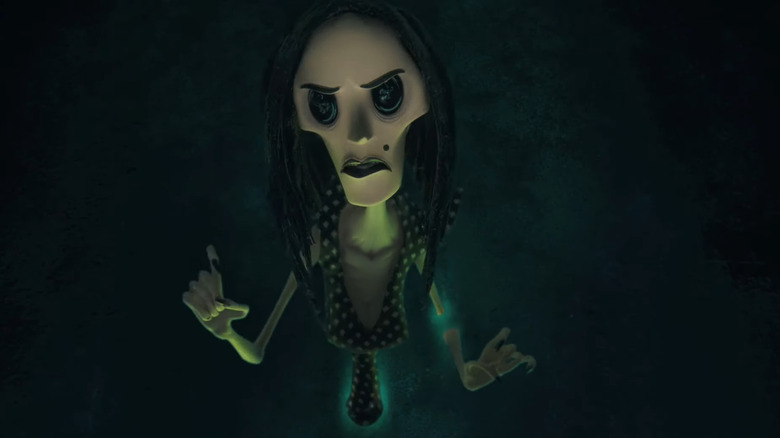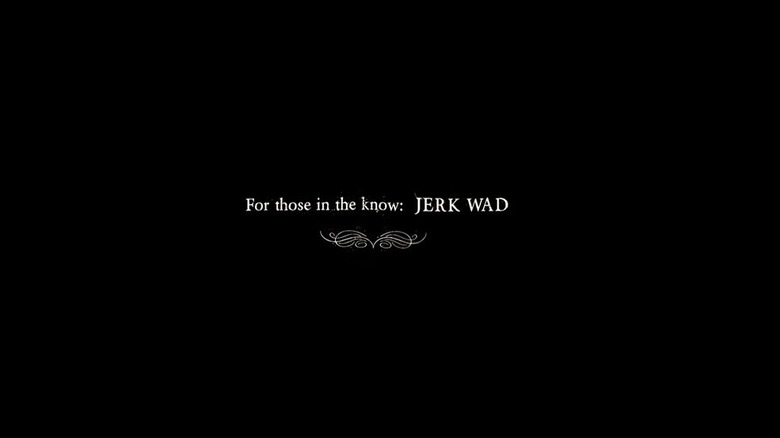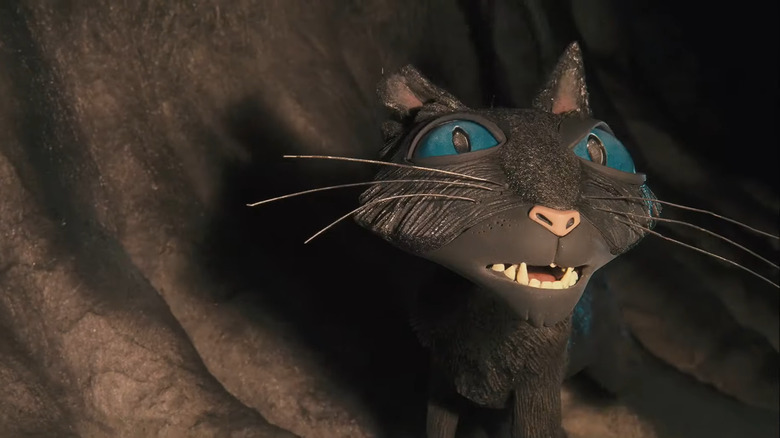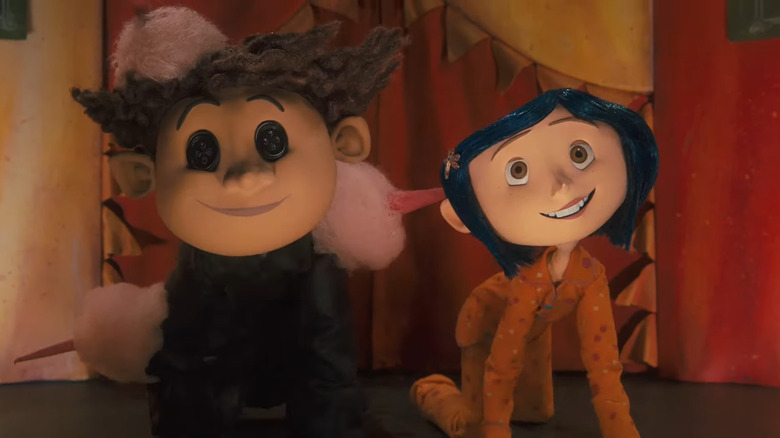Coraline Ending Explained: There's No Place Like Home
The phrase "it me" — used to identify an image, situation, or fictional character that resembles one's own experiences — wasn't a common expression in 2009. If it had been, though, a generation of moviegoers would've uttered those two words while basking in the wonderment of "Coraline," Henry Selick's stop-motion film based on Neil Gaiman's novella of the same name.
The "Coraline" filmmakers map out a hero's journey for the titular character that paints a universally relatable portrait of youth that's also specifically niche. Like every other tween, Coraline loves her parents, but is frustrated by their rules. However, her primary extracurricular — a fixation with her neighbor's rats — represents her slant toward the macabre, a trait probably shared by fewer (but no less passionate) kids in the audience. In a decade when movies and television series usually depicted their main characters as up-and-coming superstars (call it the "Hannah Montana" effect), Selick instead presented Coraline as a real person who faces real challenges, keeping her relatable even as the story ramps up the fantasy and whimsy.
The Academy of Motion Picture Arts and Sciences nominated "Coraline" for best animated feature, and with good reason. The film's visual artistry is par for the course for Selick, who made his directorial debut with "The Nightmare Before Christmas" in 1993. Within the intricate inner-workings of the "Coraline" narrative, there's a lot to unpack, particularly as the film reaches its conclusion and its layers begin to unfold and interconnect. This is the ending of "Coraline," explained.
What you need to remember about the plot of Coraline
"Let's try this one more time. My name's Coraline. I was bitten by a radioactive spider and" — wait, wrong movie. When "Coraline" begins, Coraline (Dakota Fanning) and her parents (Teri Hatcher and John Hodgman) move into a new home. As her mom and dad continue their writing careers, Coraline encounters a talkative neighbor, Wybie (Robert Bailey Jr.), who finds a doll that looks exactly like Coraline, right down to her wardrobe. Coraline dislikes her new home and yearns for more exciting people in her life. Her wish comes true when she discovers a hidden door in the wall that leads to a seemingly perfect alternate world.
This new place is the same, but different. In this new dimension, Coraline's house has the same layout, but its aesthetic is friendlier. Coraline is still an only child who lives with two parents, but this "Other Mother" and "Other Father" shower her with treats, and while they're still into horticulture, they focus on actually gardening, not just writing about it. Her neighbors are pleasant, not aggravating. Aside from everyone's button eyes, it all seems too good to be true. As you might be able to guess, it is.
What happened at the end of Coraline?
The alternate reality that Coraline discovers contains more than meets the eye — literally. When the Other Mother invites Coraline to stay with them permanently by sewing buttons onto her eyes, Coraline sees her nefarious temptations for what they are. Coraline declines the Other Mother's offer, and the Other Mother goes full goblin mode. She won't take no for an answer, threatening not only Coraline's acquaintances in the new realm, but her parents in the real world, too.
With the aid of a talking cat (Keith David), Coraline escapes her dreaded fate and returns home. In the process, she frees other souls from a decades-long curse, including Wybie's grandmother's long-lost sister. (For decades, the Other Mother used the aforementioned doll to spy on generations of children and lure them into entrapment.) Coraline's parents don't remember a thing about the Other Mother, but that's okay. Coraline gains a greater understanding of her parents and her neighbors, and uses this new perspective to revitalize her family and her community. Upon returning home, Coraline sees her world a little bit differently — and she didn't even have to sew up her eyes to do so.
No place like home
Like "The Wizard of Oz" and "Alice in Wonderland," "Coraline" leans heavily into the trope of a young protagonist who enters a fantasy world that romanticizes her home life. Dorothy encounters beings who remind her of the Kansas residents she grew up around. Alice discovers a land where every day can be as magical as a birthday, unlike her regular, school-filled existence. Coraline goes through a similar journey as she becomes first enchanted by, and then disillusioned with, the Other Mother's domain.
When Coraline explores this new world, she discovers that it's not all that big. She doesn't walk very far from the house before she somehow approaches it again, walking the length of this dimension in a matter of minutes. Here, Selick implies that if one person were to fashion a world of their own, the result would be small in more ways than one: It would be inherently close-minded and self-revolving.
The Other Mother tells Coraline she's hidden the lost children's eyes "in each of the three wonders I've made for you." At first, these "wonders" — the garden, a piece of candy, and a performing rat — seem enticing, but they mask the Other Mother's long-term intentions, a la "Hansel and Gretel." As the "Coraline" theatrical poster forewarns, the theme of "Be careful what you wish for" is front and center. Coraline all but clicks her rain boots together to depart from Emerald City.
He can't duck his wings forever
Early in the film, Coraline's elderly neighbors, April (Jennifer Saunders) and Miriam (Dawn French), prepare for the imminent death of their dog, Angus, by knitting him an angel costume that they plan to dress him in after he passes. In the finale, Angus is alive and well, but still wears the costume. As April remarks, "He can't duck his wings forever," subtly repeating one of the film's underlying messages: Don't deny morbidity, but embrace it.
As something of a secondary thesis, Selick proposes that death — and even mildly unpleasant aspects of life in general — should be acknowledged, not hidden. When the Other Mother notices the other-worldly Wybie frowning, she literally disfigures his face to ensure that he's always smiling. In this fantasy world, sadness is not allowed. Given that Coraline's home away from home turns out to be harmful, Selick is telling us that fake happiness is dangerous, too.
When she makes it back home, Coraline challenges herself to bring her own light to unpleasant situations rather than wishing them gone altogether. In the film's conclusion, Coraline is more grateful for her new home, despite her external circumstances not really changing that much. In this way, her arc recalls that of George Bailey in the perennial Christmas classic "It's a Wonderful Life." Doesn't Angus know that "every time a bell rings, an angel gets its wings"?
More than gloves
At a store, Coraline begs her mom to buy her gloves to accompany her drab school uniform, hoping to free herself from the monotony of the student body's identical outfits. Coraline's mom refuses. She sees purchasing school clothing as simply another item on her checklist, not an opportunity to affirm her daughter's desire for self-expression. At the end of the film, after Coraline's big adventure, her mom gifts her the gloves. But they're more than just gloves; they're symbols of the mended relationship between mother and daughter. Coraline's mom doesn't just accept Coraline's desire to be different — here, she actually encourages it.
Along similar lines, you'll find lots of symbolism in the film's color palette. Throughout most of the film, Selick and his team of artists depict Coraline's home as bleak and unsaturated, reflecting the protagonist's loneliness. By contrast, the fantasy version of Coraline's house is filled with warmth and color. By the time the finale comes around — and Coraline has grown as a character — things have flipped. The other world is cold and soulless, while the visuals surrounding Coraline's real home are as lovely, welcoming, and colorful as the newly-planted family garden.
What has the cast and crew of Coraline said about the ending?
A severed hand, a disfigured smile, giant bugs — the last act of "Coraline" is full of eerie imagery. In a YouTube interview with David Poland, Selick observed that "Coraline" differs from the generally "family-friendly" fare of most modern animated features. That said, Selick also pointed out that there's nothing new about embracing darker, more mature themes and visuals in animated films. In fact, it's a tradition rooted in the medium's earliest days. Specifically, Selick wanted "Coraline" to be "more connected to the first films of Walt Disney." Selick cited "Snow White and the Seven Dwarfs," "Pinocchio," "Fantasia," and "Bambi" — all released during the late 1930s and early 1940s — as inspirations.
Upon first glance, these comparisons seem mismatched. Disney movies are charming, bubbly, and light, aren't they? Well, sometimes, but the studio's first animated features didn't shy away from these stories' darker sides. Snow White running in fear through a sinister forest. Pinocchio watching with horror as his friend transforms into a donkey. Chernabog — i.e., the literal Devil — displaying his powers in "Fantasia." Bambi heading for cover while a hunter shoots his mother. The public might consider these films innocuous, but they contain some pretty primal terrors. As Selick observed, "Those films were pretty much in tune with what the Brothers Grimm were peddling when they collected all their great fairy tales."
Who — or what — is Jerk Wad?
Audience members who wait patiently for a "Coraline" post-credits scene will instead discover a cryptic message. At the very end of the credits, text appears reading, "For those in the know: JERK WAD." Huh?
Well, when "Coraline" debuted in 2009, its website encouraged moviegoers to look for a secret code in the end credits. If they returned to the website and entered the correct phrase, they could win a pair of "Coraline"-themed Nike Dunks. The code, as you may have guessed, was "JERK WAD." (In the film, Coraline calls Wybie "the jerk wad who gave me that doll.")
While it eternally ties the film to 2009, this tie-in was undoubtedly cool for those who were, in fact, in the know. In retrospect, everything about this promotion feels innocently archaic. A website supporting a movie's marketing campaign used to be a must-have for every major release; today, that isn't nearly as important as a social media presence. Speaking of, social media obviously wasn't the juggernaut in 2009 that it is now. It's hard to imagine a promotion like this not being spoiled on various social platforms today, rendering the hunt pointless. While we don't know how many winners received sneakers, there was at least one victor — and, yeah, the shoes are pretty slick.
What the ending of Coraline could mean for the franchise
Over a decade has elapsed since "Coraline" debuted and yet, despite a Hollywood landscape overflowing with sequels and cinematic universes, it remains a stand-alone feature. It looks like it may stay that way. In 2021, Neil Gaiman answered a fan question about a "Coraline" sequel on Twitter. "I'm waiting for a 'Coraline' story that's as good as or better than 'Coraline,'" Gaiman wrote. "There's no point in making something less than the first book or movie."
Nothing in the conclusion of "Coraline" sets up a continuation of the story. There's no shocking twist, and no post-credits bombshell. Coraline herself has grown as an individual, and for the time being her story is resolved.
However, "Coraline" can be viewed as one entry in a larger series in several respects. "Coraline" was Laika Studios' first-ever film. The acclaimed stop-motion company has since produced "Paranorman," "Boxtrolls," "Kubo and the Two Strings," and "Missing Link." Further, when considering Henry Selick as an auteur, "Coraline" slots well into his filmography. The movie feels akin to Selick's prior directorial work — "The Nightmare Before Christmas," "James and the Giant Peach," and "Monkeybone" — and aligns nicely with Selick's only other film since:2022's "Wendell & Wild," another stop-motion coming-of-age story about a girl who discovers who she is while facing off against manipulative figures from another world.
Coraline's alternate ending
Writer-director Henry Selick adapted "Coraline" from Neil Gaiman's 2002 novel, and while the movie contains a few slight differences from the book, both stories are largely the same. It didn't necessarily have to be this way — just ask Stephen King how he feels about Stanley Kubrick's adaptation of "The Shining." That Selick chooses to keep Gaiman's story intact says quite a bit about the director's intentions.
Perhaps the most significant change in the movie is the addition of Wybie. Wybie's presence among Coraline's neighbors adds a helpful layer to Coraline's perspective. As she learns to embrace her new home, it's not just adults and authority figures who she needs to warm up to. To thrive, she'll need to connect with kids her own age, too. And, of course, Wybie's presence changes the film's ending, albeit in minor ways. He plays a pivotal part in the movie's climax (in the book, Coraline defeats the Beldam's hand by herself), and the subplot involving the fate of Wybie's grandmother and great-aunt helps bring the story full-circle.
